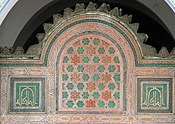Anaza

'Anazaoranaza(Arabic:عنزة;sometimes also transliterated as'anzaoranza) refers to a short spear or staff that held ritual importance in the early period ofIslam.The term gained significance after the Islamic prophetMuhammadplanted his spear in the ground to indicate the direction of prayer (qibla). Over time, 'anaza evolved into an architectural term denoting an outdoormihrabinmosques,particularly in theMaghrebregion.
Origins
[edit]The'anazawas the spear (also known as aḥarba) of Muhammad[1]and first appears as part of Muslim ritual in the year 624 CE (2 AH), when Muhammad celebrated the firstEid al-Fitr.[2]When Muhammad and the other Muslims reached themusalla(outdoor prayer space), he planted the spear in the ground and used it to indicate the direction of prayers (theqibla), much like amihrabwould in later mosques. The spear was used in this way again onEid al-Adhathe same year. The earlycaliphsexpanded on this practice, making it customary to carry a staff, sword, orbowon ceremonial occasions when ascending the pulpit (minbar), symbolizing authority.[1]The image of theanazaplanted in front of a mihrab arch also appears on some earlyUmayyadcoinage.[1]
Architectural feature
[edit]Possibly related to its symbolic use as an early qibla indicator, the term "anaza"later came to refer to an architectural feature found in many mosques in the westernMaghrebandMorocco.This architectural element designated an "outdoor" or "summer" mihrab, often taking the form of an ornate wooden screen positioned at the boundary between the sahn (courtyard) and the interior prayer hall of a mosque. It was typically aligned with the central mihrab axis of the mosque. This anaza had the function of serving as a mihrab for prayers conducted in the courtyard.[3]: 296 The wooden screen was frequently adorned with intricate carvings and paintings depicting a stylized mihrab motif and other inscriptions. Alternatively, the anaza could be a simple marking on the ground or floor of the courtyard just before the central entrance of the prayer hall, such as a semi-circular groove or recess in the middle of the step leading to the entrance.[3][4]
Woodenanazas were constructed in mosques across Morocco and the Maghreb. In Morocco they became a standard feature of "grand mosques" orFriday mosquesin particular.[4]: 54 The oldest surviving example is theanazaof theal-Andalusiyyin MosqueinFez,which dates from 1209 (from theAlmohadperiod).[4]: 133 Historical sources also mention an even olderanaza,dating from 1129 (during theAlmoravidperiod), at theQarawiyyin Mosquein Fez, but it no longer exists today and has been replaced by the currentMarinid-eraanazawhich was fabricated between 1288 and 1290.[5]Theanazain theGrand Mosque of Fes el-Jdid,which likely dates from the mosque's construction in 1276, is very similar and might be the oldest Marinidanaza.[6][4]: 133 A similar example is also found in theGrand Mosque of Meknesbut was built much later in 1715 (during the reign of theAlaouitesultanMoulay Ismail).[7]Some other post-Marinid examples also include theanazaof the 16th-centuryMouassine MosqueinMarrakesh(from theSaadianperiod).[8][3]Theanazaof the near-contemporaryBab Doukkala Mosquein Marrakesh, on the other hand, is a modern replacement of the original one.[3]
-
Details of theanazaof theQarawiyyin Mosque
-
Details of theanazaof the Qarawiyyin Mosque (central lower panel)
-
Theanazaof theGrand Mosque in Meknes,dating from 1715 but copying the form of earlierMarinidexamples
References
[edit]- ^abcTreadwell, Luke (2005). ""Mihrab and ʿAnaza" or "Sacrum and Spear"? A Reconsideration of an Early Marwanid Silver Drachm ".Muqarnas.22:1–28.JSTOR25482421.
- ^Miles, C.G. (2012). "'Anaza ".Encyclopaedia of Islam, Second Edition.Brill.
- ^abcdAlmela, Iñigo (2019). "Religious Architecture as an Instrument for Urban Renewal: Two Religious Complexes from the Saadian Period in Marrakesh".Al-Masāq.31(3): 272–302.doi:10.1080/09503110.2019.1589973.hdl:10261/212691.S2CID167107436.
- ^abcdEl Khammar, Abdeltif (2005).Mosquées et oratoires de Meknès (IXe-XVIIIe siècle): géographie religieuse, architecture et problème de la Qibla.Université Lumière-Lyon 2.
- ^Terrasse, Henri (1968).La Mosquée al-Qaraouiyin à Fès; avec une étude de Gaston Deverdun sur les inscriptions historiques de la mosquée.Paris: Librairie C. Klincksieck.
- ^Maslow, Boris (1937).Les mosquées de Fès et du nord du Maroc.Paris: Éditions d'art et d'histoire. pp. 38–53.
- ^Touri, Abdelaziz; Benaboud, Mhammad; Boujibar El-Khatib, Naïma; Lakhdar, Kamal; Mezzine, Mohamed (2010).Le Maroc andalou: à la découverte d'un art de vivre(2 ed.). Ministère des Affaires Culturelles du Royaume du Maroc & Museum With No Frontiers.ISBN978-3902782311.
- ^Salmon, Xavier (2016).Marrakech: Splendeurs saadiennes: 1550-1650.Paris: LienArt.ISBN9782359061826.




